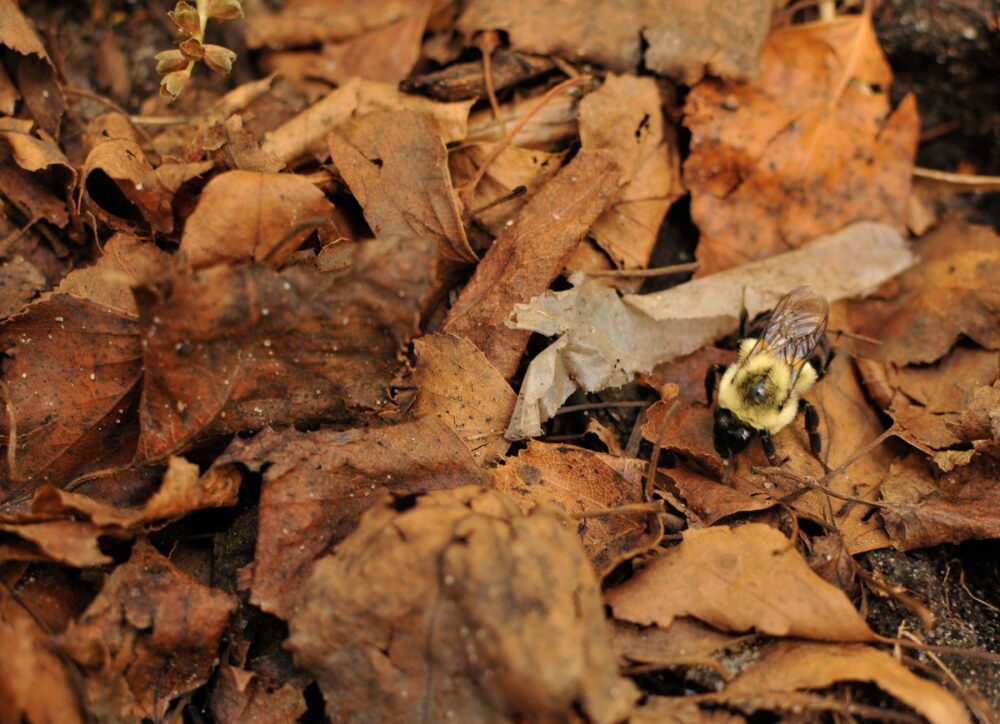
Bumble bee queen burrowing into Fall leaves (Xerces.org) Photo: Steven Severinghaus / Flickr Creative Commons 2.0
Guest blog by Jenna Stanek | August 26, 2024
Do you ever wonder where pollinators and other invertebrates go in the winter? Most of our native bees are ground nesting, or nest under leaf litter, and they spend the winter sleeping, or much less active, in the same area where they lived all summer. If you’ve provided native and diverse habitat for invertebrates and pollinators during the growing season, helping those invertebrates in the winter is pretty simple: Leave those habitats intact for the winter.
Clean up selectively and carefully
In general, consider leaving most perennials uncut through the winter. Stems hollow out when plants die back, providing cavities in which pollinators can make a home or nest. Native bee species, including small carpenter, mason, and leaf-cutter bees, will nest in hollow stems. Many butterflies will pupate and spend the winter on these plants as well. We can preserve these pollinating insects by leaving this type of plant material in the landscape for next year. There’s no real need to cut back until early spring, when new growth begins to push through. If you crave tidiness, you can always leave just one area uncut. Additionally, many perennials such as coneflowers and sunflowers can be an important food source for seed eating birds like goldfinches during the winter.
Also, never rush to cut things down; hold off until after several hard frosts. Even if the flowers or leaves are dead, the roots reclaim energy from the dying plant for healthy growth in the spring.
Some exceptions for fall trimming: Always cut back any infected or diseased plants. Badly damaged or infested foliage should be cut back and removed from infected plants. Some plants such as Bearded Iris should be cut back in the fall. The iris borers’ eggs overwinter on the leaves and stems of the plant; by cutting the leaves back you can help reduce or even eliminate borers from your garden. Wait until after the first frost because the iris borer moth remains active until then.
Leave a few areas of your yard for brush piles and bare dirt
Consider leaving some unkept areas in the spaces you manage, such as newly fallen leaves, branches and logs, and loose dirt. Or designate a spot for these unkept areas in a less visited section of your yard such as a back corner area. Brush piles and trees can provide winter habitat for our pollinators. Dead trees and hollowed branches are also useful overwintering spaces for our pollinators. For example, these elements benefit overwintering queens that need insulation (leaves), and materials to build their overwintering sites (rotting logs and loose dirt).
Leave some leaves
Leave a few out-of-the-way leaf piles in the corners of your yard and allow leaves to remain under shrubs and trees as a natural insulator. If you do this you will be providing safe harbors for overwintering pollinators. Leaves and other organic litter are essential shelter for hibernating bumblebee queens and the larvae of numerous butterfly and moth species. Many of these species will happily tuck themselves into a leaf or mulch pile for insulation. Butterflies will overwinter in a chrysalis hanging from a dead plant, native bees will overwinter in the hollow stem of a perennial plant, birds will feed on the seeds of spent sunflowers, and caterpillars will secure themselves into the empty seedpod of a plant.
Visit Xerces.org for more information. https://xerces.org/leave-the-leaves; https://xerces.org/blog/5-ways-to-increase-nesting-habitat-for-bees, https://xerces.org/blog/where-do-pollinators-go-in-winter
